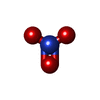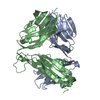[English] 日本語
 Yorodumi
Yorodumi- PDB-4e42: Structural basis for the recognition of mutant self by a tumor-sp... -
+ Open data
Open data
- Basic information
Basic information
| Entry | Database: PDB / ID: 4.0E+42 | ||||||
|---|---|---|---|---|---|---|---|
| Title | Structural basis for the recognition of mutant self by a tumor-specific, MHC class II-restricted T cell receptor G4 | ||||||
 Components Components | (T cell receptor G4 ...) x 2 | ||||||
 Keywords Keywords |  IMMUNE SYSTEM / IMMUNE SYSTEM /  Ig domain / Ig domain /  adaptive immunity / adaptive immunity /  T cell receptor / MHC T cell receptor / MHC | ||||||
| Function / homology |  Immunoglobulins / Immunoglobulins /  Immunoglobulin-like / Immunoglobulin-like /  Sandwich / Mainly Beta / Sandwich / Mainly Beta /  NITRATE ION NITRATE ION Function and homology information Function and homology information | ||||||
| Biological species |   Homo sapiens (human) Homo sapiens (human) | ||||||
| Method |  X-RAY DIFFRACTION / X-RAY DIFFRACTION /  SYNCHROTRON / SYNCHROTRON /  MOLECULAR REPLACEMENT / Resolution: 2.7 Å MOLECULAR REPLACEMENT / Resolution: 2.7 Å | ||||||
 Authors Authors | Deng, L. / Langley, R.J. / Wang, Q. / Topalian, S.L. / Mariuzza, R.A. | ||||||
 Citation Citation |  Journal: Proc.Natl.Acad.Sci.USA / Year: 2012 Journal: Proc.Natl.Acad.Sci.USA / Year: 2012Title: Structural basis for the recognition of mutant self by a tumor-specific, MHC class II-restricted T cell receptor G4 Authors: Deng, L. / Langley, R.J. / Wang, Q. / Topalian, S.L. / Mariuzza, R.A. | ||||||
| History |
|
- Structure visualization
Structure visualization
| Structure viewer | Molecule:  Molmil Molmil Jmol/JSmol Jmol/JSmol |
|---|
- Downloads & links
Downloads & links
- Download
Download
| PDBx/mmCIF format |  4e42.cif.gz 4e42.cif.gz | 178.2 KB | Display |  PDBx/mmCIF format PDBx/mmCIF format |
|---|---|---|---|---|
| PDB format |  pdb4e42.ent.gz pdb4e42.ent.gz | 141.6 KB | Display |  PDB format PDB format |
| PDBx/mmJSON format |  4e42.json.gz 4e42.json.gz | Tree view |  PDBx/mmJSON format PDBx/mmJSON format | |
| Others |  Other downloads Other downloads |
-Validation report
| Arichive directory |  https://data.pdbj.org/pub/pdb/validation_reports/e4/4e42 https://data.pdbj.org/pub/pdb/validation_reports/e4/4e42 ftp://data.pdbj.org/pub/pdb/validation_reports/e4/4e42 ftp://data.pdbj.org/pub/pdb/validation_reports/e4/4e42 | HTTPS FTP |
|---|
-Related structure data
| Related structure data |  4e41SC S: Starting model for refinement C: citing same article ( |
|---|---|
| Similar structure data |
- Links
Links
- Assembly
Assembly
| Deposited unit | 
| ||||||||
|---|---|---|---|---|---|---|---|---|---|
| 1 | 
| ||||||||
| 2 | 
| ||||||||
| Unit cell |
| ||||||||
| Details | heterodimer |
- Components
Components
-T cell receptor G4 ... , 2 types, 4 molecules ACBD
| #1: Protein | Mass: 22670.959 Da / Num. of mol.: 2 Source method: isolated from a genetically manipulated source Source: (gene. exp.)   Homo sapiens (human) / Production host: Homo sapiens (human) / Production host:   Escherichia coli (E. coli) Escherichia coli (E. coli)#2: Protein | Mass: 27154.158 Da / Num. of mol.: 2 Source method: isolated from a genetically manipulated source Source: (gene. exp.)   Homo sapiens (human) / Production host: Homo sapiens (human) / Production host:   Escherichia coli (E. coli) Escherichia coli (E. coli) |
|---|
-Non-polymers , 4 types, 218 molecules 






| #3: Chemical | ChemComp-CL /  Chloride Chloride#4: Chemical |  Nitrate Nitrate#5: Chemical | #6: Water | ChemComp-HOH / |  Water Water |
|---|
-Experimental details
-Experiment
| Experiment | Method:  X-RAY DIFFRACTION / Number of used crystals: 1 X-RAY DIFFRACTION / Number of used crystals: 1 |
|---|
- Sample preparation
Sample preparation
| Crystal | Density Matthews: 3.47 Å3/Da / Density % sol: 64.54 % |
|---|---|
Crystal grow | Temperature: 298 K / Method: vapor diffusion / pH: 5 Details: 1.5 M sodium nitrate 0.1 M sodium citrate, pH 5.0, VAPOR DIFFUSION, temperature 298K |
-Data collection
| Diffraction | Mean temperature: 100 K |
|---|---|
| Diffraction source | Source:  SYNCHROTRON / Site: SYNCHROTRON / Site:  NSLS NSLS  / Beamline: X29A / Wavelength: 1 Å / Beamline: X29A / Wavelength: 1 Å |
| Detector | Type: ADSC QUANTUM 315 / Detector: CCD / Date: 2010 |
| Radiation | Protocol: SINGLE WAVELENGTH / Monochromatic (M) / Laue (L): M / Scattering type: x-ray |
| Radiation wavelength | Wavelength : 1 Å / Relative weight: 1 : 1 Å / Relative weight: 1 |
| Reflection | Resolution: 2.7→50 Å / Num. obs: 37490 / % possible obs: 99 % / Observed criterion σ(F): 2 / Observed criterion σ(I): 2 / Redundancy: 6.9 % / Rmerge(I) obs: 0.081 / Net I/σ(I): 25.8 |
| Reflection shell | Resolution: 2.7→2.8 Å / Redundancy: 6.1 % / Rmerge(I) obs: 0.122 / Mean I/σ(I) obs: 17.8 / % possible all: 99 |
- Processing
Processing
| Software |
| ||||||||||||||||||||||||||||||||||||||||||||||||||||||||||||||||||||||||||||||||||||||||||||||||||||||||||||||||||||||||||||||||||||||||||||||||||||||||||||||||||||||||||
|---|---|---|---|---|---|---|---|---|---|---|---|---|---|---|---|---|---|---|---|---|---|---|---|---|---|---|---|---|---|---|---|---|---|---|---|---|---|---|---|---|---|---|---|---|---|---|---|---|---|---|---|---|---|---|---|---|---|---|---|---|---|---|---|---|---|---|---|---|---|---|---|---|---|---|---|---|---|---|---|---|---|---|---|---|---|---|---|---|---|---|---|---|---|---|---|---|---|---|---|---|---|---|---|---|---|---|---|---|---|---|---|---|---|---|---|---|---|---|---|---|---|---|---|---|---|---|---|---|---|---|---|---|---|---|---|---|---|---|---|---|---|---|---|---|---|---|---|---|---|---|---|---|---|---|---|---|---|---|---|---|---|---|---|---|---|---|---|---|---|---|---|
| Refinement | Method to determine structure : :  MOLECULAR REPLACEMENT MOLECULAR REPLACEMENTStarting model: PDB entry 4E41 Resolution: 2.7→44.63 Å / Cor.coef. Fo:Fc: 0.931 / Cor.coef. Fo:Fc free: 0.875 / SU B: 11.126 / SU ML: 0.227 / Cross valid method: THROUGHOUT / ESU R: 0.497 / ESU R Free: 0.316 / Stereochemistry target values: MAXIMUM LIKELIHOOD
| ||||||||||||||||||||||||||||||||||||||||||||||||||||||||||||||||||||||||||||||||||||||||||||||||||||||||||||||||||||||||||||||||||||||||||||||||||||||||||||||||||||||||||
| Solvent computation | Ion probe radii: 0.8 Å / Shrinkage radii: 0.8 Å / VDW probe radii: 1.2 Å / Solvent model: MASK | ||||||||||||||||||||||||||||||||||||||||||||||||||||||||||||||||||||||||||||||||||||||||||||||||||||||||||||||||||||||||||||||||||||||||||||||||||||||||||||||||||||||||||
| Displacement parameters | Biso mean: 41.376 Å2
| ||||||||||||||||||||||||||||||||||||||||||||||||||||||||||||||||||||||||||||||||||||||||||||||||||||||||||||||||||||||||||||||||||||||||||||||||||||||||||||||||||||||||||
| Refinement step | Cycle: LAST / Resolution: 2.7→44.63 Å
| ||||||||||||||||||||||||||||||||||||||||||||||||||||||||||||||||||||||||||||||||||||||||||||||||||||||||||||||||||||||||||||||||||||||||||||||||||||||||||||||||||||||||||
| Refine LS restraints |
| ||||||||||||||||||||||||||||||||||||||||||||||||||||||||||||||||||||||||||||||||||||||||||||||||||||||||||||||||||||||||||||||||||||||||||||||||||||||||||||||||||||||||||
| LS refinement shell | Resolution: 2.7→2.77 Å / Total num. of bins used: 20
|
 Movie
Movie Controller
Controller












 PDBj
PDBj


